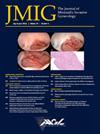剖腹产后腹壁子宫内膜异位症的发病率
IF 3.5
2区 医学
Q1 OBSTETRICS & GYNECOLOGY
引用次数: 0
摘要
研究目的腹壁子宫内膜异位症(AWE)是剖宫产(CD)的后遗症,据报道,在小型队列报告中,其发生率为 0.03%-0.45%。真正的发病率目前尚不清楚。本研究旨在确定AWE的真实发生率及其发生的风险因素。设计一项前瞻性研究,旨在测量2010年至2023年间接受原发性剖宫产的患者中AWE的发生率。利用全国性的 Vizient 临床数据库确定原发性 CD 病例,并及时跟踪 AWE 的诊断情况。研究背景全国性数据库收集了美国 500 多家学术医院和社区医院的去标识化信息。研究队列中有 2,356,503 例 CD 患者。中位年龄为[31.0岁(四分位数间距:27,35)]。18,030例(0.8%)患者确诊为AWE,93%(n=16812)发生在原发性CD之后。中位诊断时间为 2.9 年(1.46,4.91)。女性原发性 CD 后的人群发病率为 1.70/1000 人-年(1.67,1.72)。发病率随初诊 CD 时产妇年龄的增加而上升:18-24 岁 [0.90/1000 人-年 (0.86, 0.95)]、25-29 岁 [1.48/1000 人-年 (1.43, 1.53)]、30-34 岁 [1.48/1000 人-年 (1.48, 1.53)]。53)]、30-34 岁[1.79/1000 人-年(1.75,1.84)]、35-39 岁[2.21/1000 人-年(2.15,2.27)]和 40 岁及以上[2.42/1000 人-年(2.31,2.54)]。产妇年龄越大,风险越高,在统计学上呈显著的正线性趋势(ptrend<0.001)。AWE的风险因素包括私人保险[1.59 (1.54, 1.65)]、白人[1.73 (1.6, 1.79)]、CD时的吸烟状况[2.06 (1.98, 2.15)]和体重指数25-29 kg/m2[2.01 (1.92, 2.10)]。这项研究使人们对该疾病及其风险因素有了更深入的了解。本文章由计算机程序翻译,如有差异,请以英文原文为准。
Incidence of Abdominal Wall Endometriosis After Cesarean Delivery
Study Objective
Abdominal wall endometriosis (AWE), a sequelae of cesarean delivery (CD), has been reported to occur in 0.03%-0.45% in small cohort reports. The true incidence is currently unknown. This study aims to identify the true incidence of AWE and risk factors for its development.
Design
A prospective study to measure the incidence of AWE in patients that underwent primary CD between 2010 and 2023. Cases of primary CD were identified using the national Vizient Clinical Database and followed in time for diagnosis of AWE.
Setting
National database that collects de-identified information from over 500 academic and community hospitals in the US.
Patients or Participants
Cohort of patients that underwent primary CD from 2010-2023 derived from a population-based database. Identified using ICD-codes.
Interventions
None.
Measurements and Main Results
The study cohort has 2,356,503 cases of CD. Median age is [31.0 years (interquartile range: 27, 35)]. AWE was diagnosed in 18,030 (0.8%) of patients and 93% (n=16812) occurred after primary CD. The median time to diagnosis is 2.9 years (1.46, 4.91). The population incidence rate was 1.70/1000 person-years (1.67, 1.72) in women after primary CD. Incidence rates rose with increasing maternal age at primary CD: 18-24 years [0.90/1000 person-years (0.86, 0.95)], 25-29 years [1.48/1000 person-years (1.43, 1.53)], 30-34 years [1.79/1000 person-years (1.75, 1.84)], 35-39 years [2.21/1000 person-years (2.15, 2.27)], and 40 years and older [2.42/1000 years (2.31,2.54)]. Increasing risk with maternal age was statistically significant for a positive linear trend (ptrend<0.001). Risk factor for AWE include private insurance [1.59 (1.54, 1.65)], white [1.73 (1.6, 1.79)], smoking status at CD [2.06 (1.98, 2.15)], and BMI 25-29 kg/m2[2.01 (1.92, 2.10)].
Conclusion
This is the first study to calculate the true incidence of AWE. This study provides greater understanding of the condition and its risk factors.
求助全文
通过发布文献求助,成功后即可免费获取论文全文。
去求助
来源期刊
CiteScore
5.00
自引率
7.30%
发文量
272
审稿时长
37 days
期刊介绍:
The Journal of Minimally Invasive Gynecology, formerly titled The Journal of the American Association of Gynecologic Laparoscopists, is an international clinical forum for the exchange and dissemination of ideas, findings and techniques relevant to gynecologic endoscopy and other minimally invasive procedures. The Journal, which presents research, clinical opinions and case reports from the brightest minds in gynecologic surgery, is an authoritative source informing practicing physicians of the latest, cutting-edge developments occurring in this emerging field.

 求助内容:
求助内容: 应助结果提醒方式:
应助结果提醒方式:


